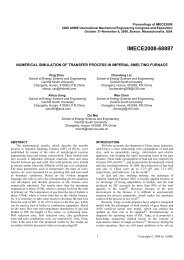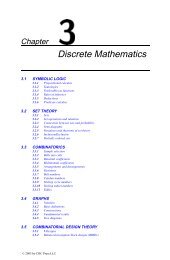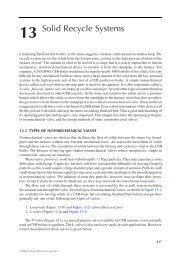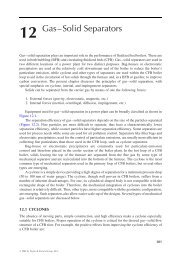Chapter 4: Geometry
Chapter 4: Geometry
Chapter 4: Geometry
Create successful ePaper yourself
Turn your PDF publications into a flip-book with our unique Google optimized e-Paper software.
4.4.4 CONCURRENCE AND COLLINEARITY<br />
Three lines ¼ Ü · ¼ Ý · ¼ ¼, ½ Ü · ½ Ý · ½ ¼, and ¾ Ü · ¾ Ý · ¾ ¼are<br />
concurrent (i.e., intersect at a single point) if and only if<br />
¬ ¼ ¼ ¼¬¬¬¬¬<br />
½ ½ ½ ¼ (4.4.11)<br />
¬ ¾ ¾ ¾<br />
(This remains true in oblique coordinates.)<br />
Three points ´Ü ¼ Ý ¼ µ, ´Ü ½ Ý ½ µ, and ´Ü ¾ Ý ¾ µ are collinear (i.e., all three points<br />
are on a straight line) if and only if<br />
¬<br />
¬<br />
Ü ¼ Ý ¼ ½<br />
Ü ½ Ý ½ ½ ¼ (4.4.12)<br />
Ü ¾ Ý ¾ ½<br />
(This remains true in oblique coordinates.)<br />
Three points with polar coordinates ´Ö ¼ ¼ µ, ´Ö ½ ½ µ, and ´Ö ¾ ¾ µ are collinear<br />
if and only if<br />
Ö ½ Ö ¾ ×Ò´ ¾ ½ µ·Ö ¼ Ö ½ ×Ò´ ½ ¼ µ·Ö ¾ Ö ¼ ×Ò´ ¼ ¾ µ¼ (4.4.13)<br />
4.5 POLYGONS<br />
Given ¿ points ½ in the plane, in a certain order, we obtain a -sided<br />
polygon or -gon by connecting each point to the next, and the last to the rst, with a<br />
line segment. The points are the vertices and the segments ·½ are the sides<br />
or edges of the polygon. When ¿we have a triangle, when we have a<br />
quadrangle or quadrilateral, and so on (see page 324 for names of regular polygons).<br />
Here we will assume that all polygons are simple: this means that no consecutive<br />
edges are on the same line and no two edges intersect (except that consecutive edges<br />
intersect at the common vertex) (see Figure 4.9).<br />
FIGURE 4.9<br />
Two simple quadrilaterals (left and middle) and one that is not simple (right). We will treat<br />
only simple polygons.<br />
¾<br />
¿<br />
<br />
½<br />
¿<br />
½<br />
¾<br />
¿<br />
<br />
½<br />
¾<br />
<br />
© 2003 by CRC Press LLC










